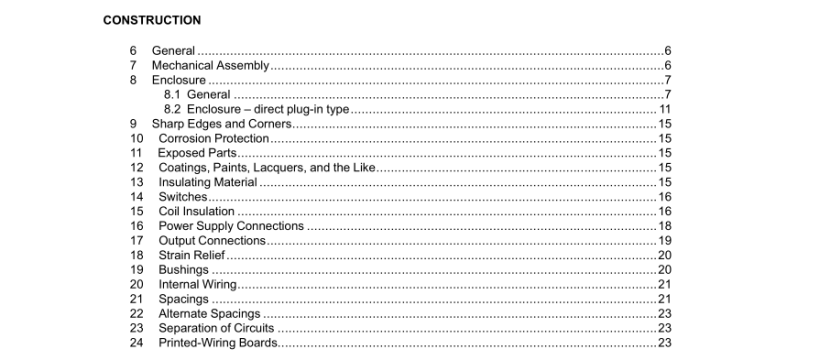UL 697-2021 pdf download.Toy Transformers.
26 Leakage Current Test 26.1 A transformer, tested in accordance with 26.3 – 26.7 shall not have a leakage current higher than 0.5 mA. 26.2 Leakage current refers to all currents, including capacitively coupled currents, that may be conveyed between exposed surfaces and ground or other exposed surfaces of a transformer. 26.3 All exposed surfaces, including output terminals, are to be tested for leakage currents. The leakage currents from these surfaces are to be measured to the grounded supply conductor individually as well as collectively where simultaneously accessible, and from one surface to another where simultaneously accessible (except not from one output terminal to another). Parts are to be considered exposed surfaces unless guarded by an enclosure in accordance with Enclosure, Section 8. Surfaces are to be considered simultaneously accessible if they can be readily contacted by one or both hands of a person at the same time. 26.4 If a surface other than metal is used for the enclosure or part of the enclosure, the leakage current is to be measured using a metal foil with an area of 4 by 8 inches (10 by 20 cm) in contact with the surface. Where the surface is smaller than 4 by 8 inches, the metal foil is to be the same size as the surface. The metal foil is not to remain in place long enough to affect the temperature of the transformer. 26.5 The measurement circuit for leakage current is to be as shown in Figure 26.1. The measurement instrument is defined in (a) – (d). The meter actually used for a measurement need only indicate the same numerical value for a particular measurement as would the defined instrument. The meter used need not have all the attributes of the defined instrument.
a) The meter is to have an input impedance of 1500 ohms resistive shunted by a capacitance of 0.15 μF. b) The meter is to indicate 1.11 times the average of the full-wave rectified composite waveform of voltage across the resistor or current through the resistor. c) Over a frequency range of 0 – 100 kHz, the measurement circuitry is to have a frequency response (ratio of indicated to actual value of current) equal to the ratio of the impedance of a 1500 ohm resistor shunted by a 0.15 μF capacitor to 1500 ohms. At an indication of 0.5 mA, the measurement is to have an error of not more than 5 percent. d) Unless the meter is being used to measure leakage from one part of the transformer to another, the meter is to be connected between the accessible parts and the grounded supply conductor.
26.6 A sample of the transformer is to be tested for leakage current starting with the as-received condition, that condition being without prior energization except as may occur as part of the production-line testing. The supply voltage is to be adjusted to 110 percent of the rated voltage of the toy transformer or 120 V, whichever is greater. A resistance load is to be prepared in advance for the transformer. The load is to be separately adjusted to consume the transformer rated output (watts or volt-amperes) at rated voltage. This load is to be connected to the transformer output terminals prior to the start of the test sequence. The test sequence, with reference to the measurement circuit ( Figure 26.1), is to be as follows: a) With switch S1 open, the transformer is to be connected to the measurement circuit. Leakage current is to be measured using both positions of switch S2, and with the transformer switching devices in all their positions. b) Switch S1 is then to be closed, energizing the transformer and the load on the output terminals, and within a period of 5 seconds the leakage current is to be measured using both positions of switch S2 and with the transformer switching devices in all their positions. c) Leakage current is to be monitored until ultimate results are obtained. Both positions of switch S2 on the leakage current meter are to be used in determining compliance. Ultimate results are to be considered attained by operation for a period of 1 hour. 26.7 A sample is to be subjected to the complete leakage-current test program as covered in 26.6 without interruption for other tests. The transformer shall then comply with the Dielectric Voltage-Withstand Test, Section 35. 27 Leakage Current and Dielectric Voltage-Withstand Test After Humidity Exposure 27.1 A toy transformer is to be exposed for 48 hours to air having a relative humidity of 90 – 95 percent at a temperature of 32.0 ±2.0°C (89.6 ±3.6°F). UL 697-2021 pdf download.
UL 697-2021 pdf download
